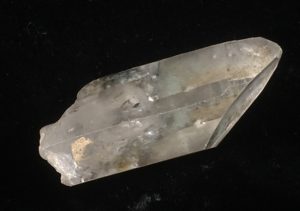January brings a new year and new opportunities for contemplation. Many take this occasion to make resolutions, though the new year is also an opportunity to reflect on the past. This month, we look to the Museum’s past to celebrate the 165th anniversary of the birth of our founding naturalist, Laura Hecox. And for this month’s Close-Up, we examine Laura’s geology specimens, their history, and how they enhance her legacy.
The three specimens include:

[Stibnite, from Nevada], Sb2S3. An ore of antimony, stibnite often occurs in the form of long, prismatic crystals. Humans have long been aware of stibnite: it’s one of several cosmetics used by ancient Egyptians to adorn the eyes. Today, you can find it in fireworks, batteries and metal bearings. People have even found stibnite in the nearby New Almaden Mine!
[Cinnabar, from Napa], HgS. Cinnabar is a toxic ore of Mercury. Although it can be found in crystal form, it usually takes the shape of a big hunk of beautiful, red cinnabar. In the past, people often sought cinnabar for its mercury (drops of liquid mercury are sometimes bound within its crystals), which was once used to separate gold from ores and stream sediments.

Due to its characteristic bright red color, it was often used for decorative or artistic purposes; the pigments known as “vermillion” and “Chinese Red” were made of cinnabar. But it’s as poisonous as it is beautiful. Prolonged exposure to cinnabar may inflict skin rashes, and even damage to the kidneys and nervous system.
[Quartz, unknown location], SiO2. Quartz is one of the most abundant minerals found on Earth’s surface. Though generally clear and colorless, small impurities can create prized colorful specimens like amethyst. From gemstones to stone tools and glass-making, quartz has an incredible variety of uses.

Recently, as part of the work of our Collections intern Isabelle West, these specimens were rediscovered in our geology cabinets and relocated to the dedicated Hecox Collection cabinet.
Laura Hecox was born in 1854 to Santa Cruz lighthouse keeper Adna Hecox. She was an avid collector, even in childhood. Her father built cabinets to house the rocks, shells, fossils, and artifacts she gathered from the natural world surrounding the lighthouse. She eventually became keeper and showcased these materials in a small museum during the lighthouse’s public hours, which grew quite popular.
In 1904, she gifted much of her diverse collection to the City of Santa Cruz, founding what is now our Santa Cruz Museum of Natural History. Her collection was sorted into the various components of the Collections: her shells became a part of our malacology department, her egg specimens, our oology department, and her rocks the foundation of our geology department.
But we now recognize that, when together, Laura’s specimens carry more meaning than the natural histories they represent individually. Reunited in one Laura Hecox Collection, they embody the unique story of a woman in science — an insatiably curious observer — who showed by example that anyone can be a naturalist.
These specimens mark a point of progress in our work to preserve and promote Laura’s legacy. As we think about her story, set against the backdrop of a Victorian-era boom in collecting natural history specimens, we might wonder what Laura would think of modern rock-collecting.
While we are big fans of hands-on learning, we have to stress the importance of researching the legality of collecting geologic specimens. Aspiring rockhounds, be sure to ask yourself: how much should I take? Who owns the land I’m on? What restrictions are in place and why?
Whether you’re hunting for fossils, rocks or petrified wood, regulations vary. Check websites for local beaches, parks, and natural spaces. For a great overview of rock-hounding and related laws, check out the comprehensive site Gator Girl Rocks.
Finally, these specimens prompt us to think about the different levels of the past: these rocks were collected over 100 years ago, which certainly feels like a long time. Yet they belong to a different scale where 100 years is more like the blink of eye — perhaps even less.
Gypsum crystals from the Cave of Crystals in Naica, Mexico, grow at a nearly imperceptible rate of 14 femtometers per second. That means those crystals would take over 3,400 years to reach the width of a penny. Though difficult to grasp at this scale, understanding deep time is important for understanding our natural world.
In their engaging review of public understandings of deep time, the British Natural History Museum notes that navigating deep time is enhanced by the use of meaningful, contextualized events like birthdates. To better situate 2019 within your personal timeline this January, come check out Laura Hecox’s rocks or join us for her birthday beach cleanup!

